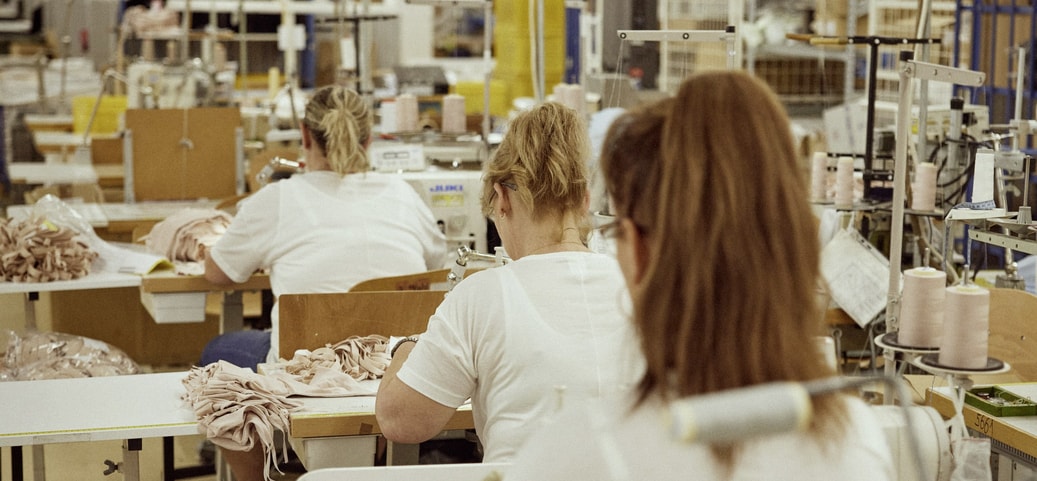Slow Fashion: What sustainable fashion really means
The term «fast fashion» is widespread nowadays and applies to almost every major fashion chain that convinces its clientele not primarily with quality, but above all through a huge variety of constantly changing collections. The counterpart to this is – who would have guessed – slow fashion! What exactly slow fashion is, how it differs from fast fashion and what goals go hand in hand with it, we want to explain in this article.
by CALIDA
September 27, 2024•3 min reading time

Slow fashion: key to timeless elegance and sustainability.
Table of Contents
Slow fashion vs. fast fashion
The fashion industry is one of the biggest burdens on our environment and also entails massive human rights violations in many countries. Primarily to blame for this is fast fashion. As mentioned before, this is the fast-moving production and trade of huge quantities of clothing, much of which never ends up in the store or is sold. The weekly changing collections of well-known fashion chains not only create a lot of environmentally harmful waste.
Especially the producers, i.e. the seamstresses and industrial workers, suffer from health problems, starvation wages and an unimaginable workload. Because often, they are exposed to toxic chemicals or a dilapidated infrastructure. A frightening example is the Rana Plaza textile factory in Bangladesh which collapsed in 2013.
In addition to the environment and the producers, we as customers are also affected by the poor quality resulting from cheap materials and poor workmanship. Because fast fashion garments can often only be worn for a few months or even weeks before you have to throw them out and replace them. The cycle of cheap production and short wearing time of fast fashion clothes starts all over again if it’s not broken by sustainable, social, and quality alternatives like slow fashion.

The 5 pillars of slow fashion: Definition & goals
We now know that fast fashion is an enormous burden on people and the environment. But how does fast fashion stand out from the fast-moving fashion industry? The main objective, as the name suggests, is to slow down the value chain. This way, more time can be invested in high-quality processing and renewable raw materials. The quality improves, clothes are worn longer, and new garments are bought less quickly. A win-win situation!
Organic cultivation of raw materials
At the beginning of the value chain are the raw materials. Already here, the slow fashion movement is campaigning for organic farming. Cotton and other plants needed to produce clothing should grow organically and without the use of pesticides or chemical fertilisers.
Monocultures are abolished. Instead, a natural cycle is created on cultivated land, which protects the soil. The locations of cotton plantations are also chosen to make short transport routes and water savings possible.
Environmentally friendly production
Once the raw materials are available, the process to the finished garments begins. The plants have to be harvested, sorted out, spun into fibres and finally woven into lengths of fabric. All these steps are already largely carried out by machines and consume a lot of energy. When the fabrics are subsequently dyed, the chemical textile dyes used in the fast fashion industry end up directly in the groundwater.
Slow Fashion advocates slowed-down and controlled processes in the production of clothing, with the intention of saving energy and water as well as avoiding toxic chemicals. Local companies are contracted, which are subject to strict guidelines and controls.
Fair & controlled trade
In the fast fashion industry, the focus is on quantity. Sufficient products from the current collections must be available for each and every consumer at all times – both online and offline. In the worst case, clothes that are not sold in the sale end up in the rubbish.
Slow fashion brands, on the other hand, often produce a manageable number of garments at the beginning of a collection. Once these pieces have been sold, they are only produced on demand to avoid overproduction and the resulting waste.
In addition, slow fashion brands usually rely on a proven selection of basic pieces and a smaller range that is sold throughout the year. New, short-lived collections are rarer and also adapted to the needs of customers in order to avoid overproduction.
Social standards
Child labour, starvation wages, and 80-hour weeks: In the fast fashion industry, all these and other unimaginable social burdens are not uncommon. With slow fashion, all this should no longer happen. Brands rely on fair pay along the entire value chain, strict control of working conditions in all factories, limitation of working hours, prohibition of child labour, and many other social standards.
Long wearing time due to high quality
A slowed-down value chain that allows for the natural growth of raw materials and the containment of working hours can only be implemented if the constant demand for new clothing also decreases. To break out of the fast-moving cycle of the fast fashion industry, slow fashion brands therefore also focus on the particularly high quality of their goods. The robust, easy-care, and high-quality processed garments can be worn for longer and only need to be replaced after many years.

The often higher prices for sustainable and fairly produced fashion are due to better wages, high-quality textiles dyes, local production, compensation for CO2 emissions and much more. However, if you consider the possible wearing time and longevity of high-quality produced garments, this price usually pays off.

How can I recognise slow fashion?
Unfortunately, terms like “slow fashion”, “organic”, “ecological” or “fair” are not protected. This makes it difficult to distinguish between slow fashion and greenwashing. Information about social commitment, production conditions and sustainability is therefore primarily provided by labels with which the entire brand or individual garments present themselves.
The best known and, at the same time, particularly recommendable labels are the Made in Green by OEKO TEX and the GOTS labels as well as the Blue Angel. All three labels identify garments that have been produced under socially fair and sustainable conditions. If you are looking for clothing made from organic cotton, the Biocotton or ProPlanet label is recommended. Social production and fair trade are indicated by certificates such as the Fairtrade label.
Discover more interesting blog posts:


